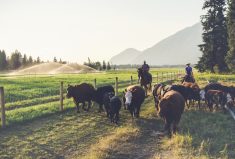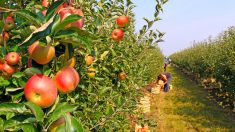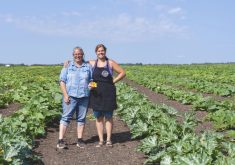
[UPDATED: Mar. 23, 2021] The past year has shone a sometimes not very flattering light on Canada’s ailing food system, but it has also revealed new challenges and exciting opportunities to bring about long overdue changes for the farming and foodservice industry.
For Rebecca Mackenzie, president and CEO of the Culinary Tourism Alliance, it’s time for a fundamental paradigm shift based on increased transparency and meaningful connections between farmers, chefs and consumers.
Her goal is to grow the role of the Culinary Tourism Alliance at the forefront of it all, leading the charge.
Is that good news for farmers?
The non-profit alliance’s mission is to make farming and the food sector a tourism destination by using history, heritage and culture to create a package that attracts consumers to the places and the people where their food is produced.
Read Also

Summer Series: Make retirement your best years
With recent increases in land prices, farmers exiting agriculture will realize an influx of cash. But after a lifetime of…
It’s little wonder Mackenzie is where she is. She’s no stranger to agriculture, the culinary scene or tourism. *She is studying global management at Royal Roads University and has a background with the award-winning Taste Trail in Ontario’s Prince Edward County, including managing membership, their visitors guide and much more. She also sits on a variety of professional boards from the Tourism Industry Association of Ontario to the United Nations World Tourism Organization’s Gastronomic Tourism Network.
But what is the Culinary Tourism Alliance? And do farmers know about it?
Established in 2006, the Ontario Culinary Tourism Alliance (OCTA) was created as part of the Ontario Ministry of Tourism, Culture and Sport’s 10-year strategic plan. “They were very forward-thinking in that they recognized there’s only one thing every consumer does at least three times a day when they travel, and that’s eat and drink,” says Mackenzie. Food was seen as a way to create meaningful connections and have a positive impact on Canada’s visitor economy.
The alliance doesn’t just provide marketing, it also helps build relationships between farmers and chefs so they can better understand each other’s operations, work more collaboratively, and increase profitability. To date, its Feast On program has 159 certified restaurants, 34 certified purveyors and numerous industry partners including Foodland Ontario, Ontario Pork and Dairy Farmers of Ontario, among, other commodity boards.
It’s also posting some significant numbers. In 2019, Feast On-certified restaurants reported $30 million in Ontario food purchases from farmers, artisans and distributors who source locally grown and produced products. This number has steadily increased over the program’s six-year history. 2019 also saw Feast On restaurants spend an annual average of $193,000 on local food (a 2.6 per cent increase from the previous year).
In 2016, the Culinary Tourism Alliance dropped Ontario from their name and set their sites on loftier goals, expanding their services to destinations around the globe. Registering as a non-profit organization, they generate revenue from membership fees, certification fees and fees for professional services.
The Feast On program fees for operators are being waived through to December 2021 with the help of funding support from the Federal Regional Relief Recovery Program and provincially from Ontario’s tourism and agriculture ministries. With initiatives from Saskatoon to Scotland, the Culinary Tourism Alliance helps to create innovative culinary tourism strategies with sustainability and capacity building in mind.
“Culinary tourism starts with a base ingredient, and that’s agriculture,” says Mackenzie. With this in mind, the Culinary Tourism Alliance’s assessment of a new place always starts with a look at its farms and fisheries. It’s a look at whether farmers are participating in local markets, hosting on-farm experiences or servicing the food industry.

Next, they look at the added-value food and beverage industry like dairies and cideries to see how they’re contributing to consumer education, who they sell to and how they add to the local taste of place. Last, the alliance looks at existing culinary experiences, attractions and events — the full culinary tourism value chain, all of which contributes to a vibrant food system.
Major accomplishments
There are many feathers in the cap of the Culinary Tourism Alliance but Mackenzie is quick to point out their most recent accomplishment: It’s Ontario’s largest tourism recovery strategy, which they’ve named the Great Taste of Ontario, and it is bringing together over 90 partners including everyone from destination marketing organizations to sector organizations like Indigenous Tourism Canada, the Winery Marketing Association of Ontario and more.
The public-facing side encourages Ontarians to rediscover the culinary gems of their backyard, and — when it’s safe to do so — the other foodie delights of the province. Through culinary itineraries and a passport program where people can check into locations, the alliance can get a robust set of metrics to help them look at the way Ontarians are reconnecting with their food. Additionally, those who enjoy the passports are able to enter contests for unique prizes and donate to charities that specialize in food security. It is hoped that CTA can help re-stimulate the economy at a trying time for the industry.
On the industry side, the Great Taste of Ontario program has encouraged more purveyors and restaurants to get involved in the Feast On program by waiving the fees for 2020-21. As a result, 14 new restaurants and two new purveyors have already registered and met the criteria to date with many more in the pipeline. In addition to the extensive marketing of the program which is featured in the Globe & Mail and has caught attention from the media at large, certified businesses will also gain access to educational tools to help them through the recovery phase of the COVID-19 pandemic and build more resilient business models.
The third prong of the program also addresses sustainable development goals for restaurants and culinary destinations as well as a cultural culinary diversity program.

The barriers, and the opportunities to knock them down
North American trends are showcasing a significant upwards trend in agritourism at a time when major disruptions in the market are highlighting a need for diversified revenue. Mackenzie doesn’t shy away from acknowledging some of the gaps that exist in Canada’s culinary story but she does see them as opportunities. She sees a disconnect between large-scale farms and their consumers in part because they work through commodity boards who tell their stories for them. For her, now is the time to acknowledge and make a major change towards a more sustainable business model based on transparency.
Like many big farming decisions, it requires a step back. “What do you want?” asks Mackenzie. Priorities become crucial. “Do you want to build something for your kids, the next generation? Do you want to grow something for your community?” It all starts with such questions.
Agritourism can be one way to accomplish specific goals but farmers need to practice due diligence before determining how to get involved.
For Mackenzie, one of the largest hurdles is the inability for Canadians to easily trade between provinces. It’s difficult for a distillery in Saskatoon to get their spirits into Ontario’s buyer and retailer of alcohol, the LCBO, thereby opening new markets and increasing consumer awareness of their taste of place story. However, every obstacle is an opportunity to knock it down and that’s why the homework is so important. Without it, businesses can easily be discouraged by the roadblocks at all levels of government.
That aside, there are options for farmers to use agritourism to create new revenue streams. One of the major financial benefits of agritourism at all levels is to create direct-to-consumer sales that provide an increase in profit. The other is attracting business during a farm’s shoulder season.
Farms and fisheries can consider another revenue stream — selling at their local farmers market. While this is a means of driving sales, Mackenzie points out that the marketing value of a farmers market is also important. It’s a way to tell a farm’s story and connect directly with a new consumer.
Going beyond that, bringing people to the farm to purchase an added value product is another means of diversifying revenue streams with direct-to-consumer sales. A dairy farm that makes cheese may set up a farm store on site to sell their artisan cheese. A winery will do better selling their wines at the vineyard than they will in the liquor store. These producers are farmers first but are entrenched in added value processing and agritourism.
Finally, some farms decide to offer an on-farm educational experience for visitors. When priced responsibly, this can be a wonderful addition to a farmer’s shoulder season revenue and can help tell the food story of the area. It can include anything from a stunning long-table dinner to climbing into some waders and getting waste deep in a cranberry bog. For the consumer it’s a chance to make a meaningful connection with a place. For the farmer it’s a chance to tell their story and get creative while financially stimulating their business.
It’s a chance to get involved in telling Canada’s culinary story and to entice people to eat seasonally and locally. That is what the Culinary Tourism Alliance is all about.
*Update: the article originally stated that Rebecca Mackenzie had a masters in global leadership from Royal Roads University.
















